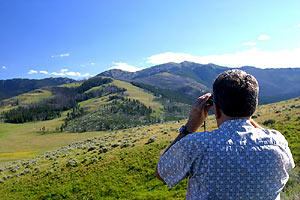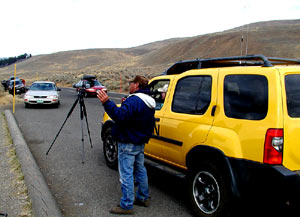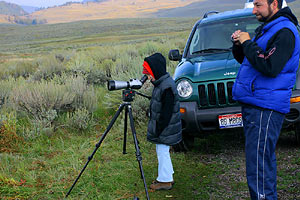|
All photos by
Tim Springer
and
Christine Baleshta
|
|

One of the great attractions of Yellowstone for me and many others is the opportunity to see so much wildlife
you can't see elsewhere. There are so many different kinds of animals in the park that you could spend a lifetime
there and still be surprised everyday.

Wildlife viewing is always hit and miss, but there are ways to improve your chances. All visitors to the park see wildlife
and everyone has chance encounters, but there are a few folks who consistently see more.
Focus
Improving your odds can be as simple as narrowing your focus. If you want to see wolves,
then don't spend half your time at the thermal features.
People often say it was a good trip but we didn't see a bear.
If you don't spend time where they are at when they might be there you probably won't see one.
Figure out what is important to you and do that.
Too much focus can be a bad thing, though. I've watched intently for badgers and never saw
one until I blew them off and forgot about them and then there they were.
Timing
The first rule of animal viewing is to get up early and stay out late.
Rick McIntyre, the local Park wolf expert demonstrates this to the extreme
by being in position as the sun comes up and then going home around noon.
At dusk he's back out until it's too dark to see.
He's becoming a bit feral though so keep your distance.

As the seasons progress animals' routines change. In winter they tend to be visible throughout the day while in summer they typically move up to the cool high country and only come out at night.
Morning is better than evening so if you can be where the animals are at dawn, your chances increase dramatically.
It helps to have lodging as close to your viewing destination as possible.
One problem with morning and evening viewing is driving in the dark which can be a dangerous proposition in Yellowstone
with large animals everywhere. Our compromise with that consisted of getting up early and arriving just
past dawn so we had a little driving light and then leaving just before we lost visibility.
You might miss some animal viewing that way but you might miss them with your car as well.
Networking
As you enter the Park ask the ranger taking your money
about recent wildlife sightings. They are typically up on the latest news and give some good information,
or can direct you to someone who might know. The rangers throughout the Park are very helpful
and like to see the animals, too, so they listen for daily reports.
Gas station attendants hear it all so try them as well.

Driving
One of the easiest ways to find animals is to just drive around until you find a critter jam. Everyone wants to
see the wildlife so we all stop. Sometimes it's a chimpmunk - sometimes it's a grizzly.
Please be patient with others. You may have seen 100 bison crossing the road for 6 days in a row
now but this might be a 6 year olds first so let them enjoy it.
If it's something you want to see and it's
safe be willing to bail out of the car and leave a sacrificial driver to deal with the vehicle. It can be your turn next time.
Vehicle
If you can chose what vehicle you drive to the Stone pick something with that sits up
high and has good visibility.
It facilitates wildlife spotting considerably. If you take a diesel or Harley please shut it off immediately
when stopping near others
because those things are noisy and don't really add to others "wilderness" experience. I've had diesel vehicles
drown out wolf howling sessions.
Most annoying. But if that's what you have bring it!
Hiking
When I first experienced Yellowstone I thought that if I went deep into the backcountry I was going
to see more animals. They would be avoiding the road and people and I was going to put the sneak on them and see
a lot more than people watching from cars. The first year that was almost true with the bears. However I have not experienced
it that way since.
I rarely see much on hikes at all. We do see some things but usually we hike in the middle of the day when the animals are bedded
and you don't cover that much ground compared to a car (or at least I don't). When you do see something it is really
special though because it's usually just you and it.
But if I really want to see animals I stay in my vehicle. You can also get much closer to animals for photos in
cars because they aren't as intimidated when they don't see your human outline.
Author - Tim Springer
Photography - Tim Springer
|
Click for larger image
|
|

